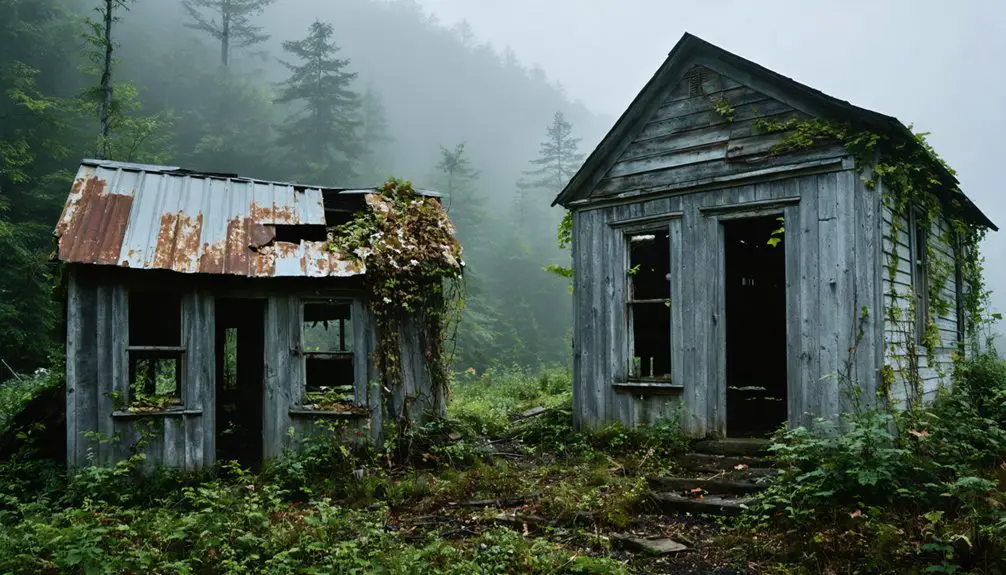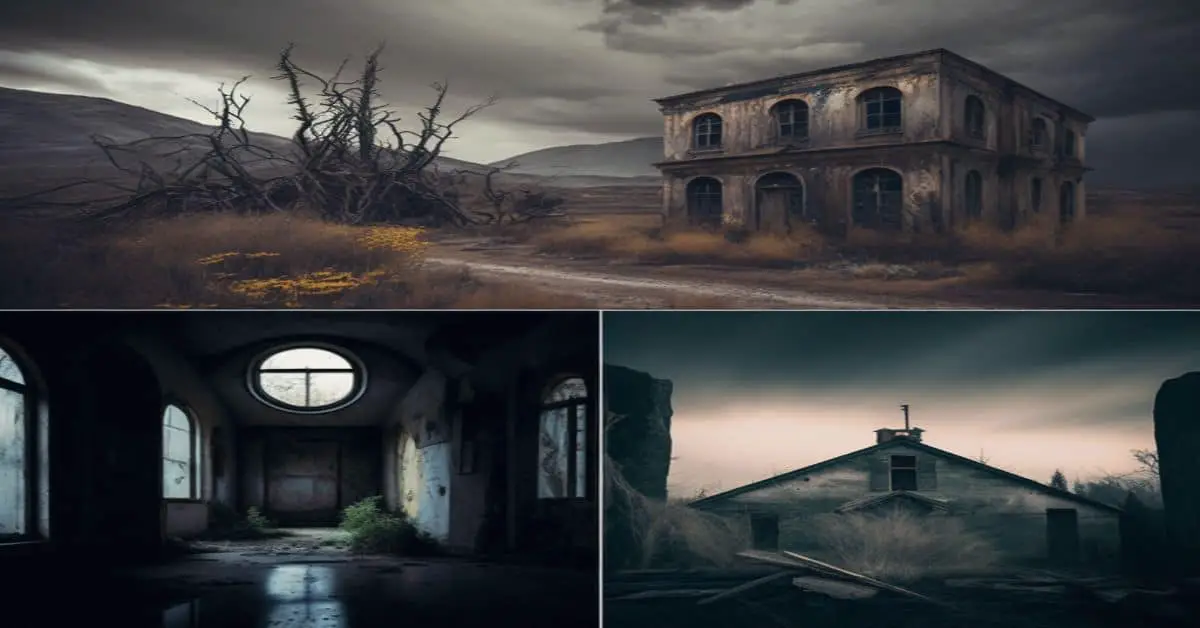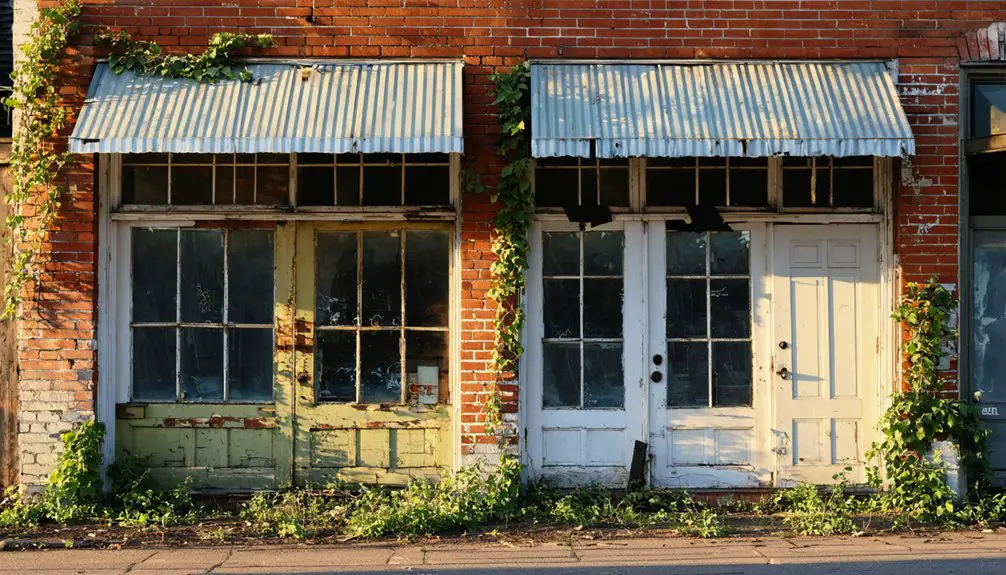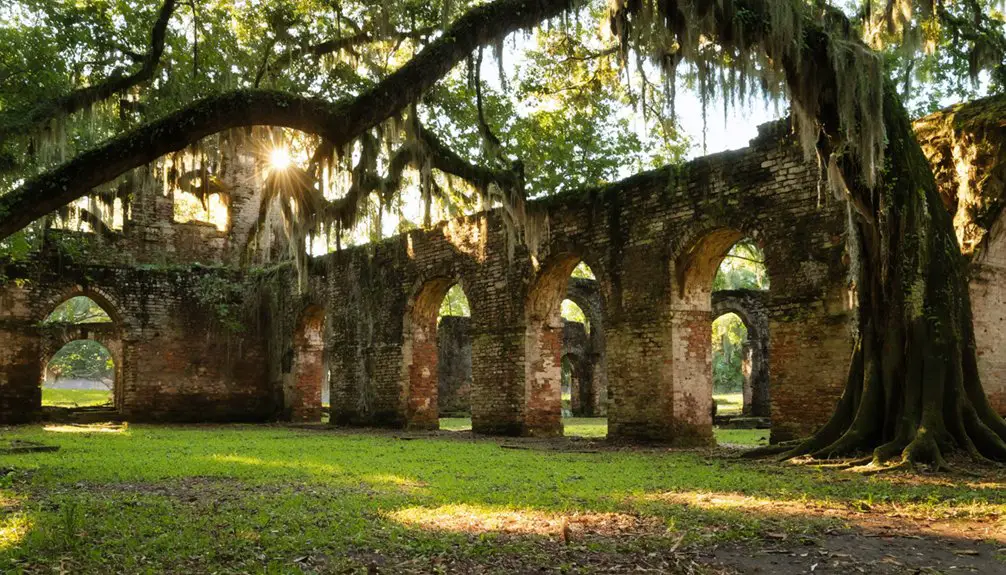You’ll discover Lost Cove nestled along the North Carolina-Tennessee border, where Morgan Bailey established a remote mountain settlement before the Civil War. This independent community of 100 residents thrived through logging, farming, and moonshining until 1957, when the last families departed. Today, you can trek to this ghost town‘s remnants in Yancey County to find three standing structures, a historic cemetery, and countless stories of resilience waiting to be uncovered.
Key Takeaways
- Lost Cove is an abandoned mountain settlement on the North Carolina-Tennessee border that became a ghost town in 1957.
- The remote community thrived through logging, farming, and moonshining before declining due to depleted timber resources and railroad service changes.
- Only three standing houses, a cemetery, and scattered artifacts remain today, including the rusted remains of Swin Miller’s Chevy.
- The site requires a challenging hike to access, as no direct roads lead to the ghost town’s location in Yancey County.
- Founded by Morgan Bailey before the Civil War, Lost Cove existed in jurisdictional limbo between states, fostering independence and self-sufficiency.
The Birth of a Mountain Community
Nestled in the rugged terrain of Poplar Gorge, Lost Cove emerged as a mountain settlement shortly before the Civil War when Morgan Bailey established his homestead along the North Carolina-Tennessee border.
Like a hidden jewel in Poplar Gorge, Lost Cove took root when Morgan Bailey carved his homestead from the wilderness borderlands.
You’ll find the community’s origins rooted in about 400 acres of surprisingly fertile soil, tucked away above the Nolichucky River in what’s now part of Pisgah National Forest.
Bailey acquired the land through a deal with a Native American, trading ten dollars and a shotgun for the property.
The geographic challenges that defined Lost Cove’s character also shaped its destiny.
Due to multiple locations sharing the name, Lost Cove is often referenced as a place name disambiguation.
You’d have discovered a fiercely independent settlement, isolated from the outside world by steep mountainsides and challenging terrain.
This isolation attracted settlers who sought both freedom and opportunity, creating a self-sufficient community where families could farm the rich mountain soil while maintaining their distance from government oversight and interference.
Life in the Secluded Valley
Though isolated from the outside world, Lost Cove’s population of roughly 100 residents forged a vibrant mountain community centered around family farms, kinship ties, and mutual support.
You’d find daily life revolved around working the rugged, loamy soil and harvesting hidden resources from the surrounding forest. The community’s resilience shone through their resourceful adaptations – from subsistence farming to moonshining operations that generated essential income. The CC & O Railway provided vital connection to outside markets. Women would come together annually for seasonal canning, preserving the harvest that sustained families through winter.
When you weren’t tending crops or processing timber at the local sawmills, you’d gather at the church or school for community events. These gatherings strengthened bonds through storytelling, sermons, and seasonal celebrations.
Despite the physical demands of mountain life, you’d rely on neighbors for help and participate in an informal system of governance that maintained order through traditional mountain customs.
Railroads and the Logging Legacy
Following the Civil War, Lost Cove’s prosperity emerged from its abundant timber resources in the surrounding Pisgah National Forest, where Morgan Bailey established the first logging operations.
You’ll find that railroad expansion played a significant role in the town’s development around 1910, connecting this remote settlement to wider markets and enabling efficient timber transportation from the dense mountainous terrain.
Like the maroon colonies that once existed in the Dismal Swamp, the wood industry’s success funded essential community infrastructure, including a schoolhouse.
The town became known as a place where moonshiner frolics went undisturbed in the isolated mountain setting.
However, as local timber supplies dwindled and railroad services shifted focus to coal transport, the town’s economic foundation began crumbling.
Without alternative transportation routes and despite residents’ unsuccessful petitions for road access, Lost Cove’s isolation deepened.
Today, you can hike to the site where rusted vehicles and a few remaining structures tell the story of a once-thriving logging community.
Moonshine and Mountain Culture
If you’d explored Lost Cove’s rugged terrain during Prohibition, you’d have discovered moonshine stills tucked away in the dense forest and steep hollows, where residents perfected their craft away from prying eyes.
The community’s unique position along an unclear state border between Tennessee and North Carolina provided moonshiners with natural protection from law enforcement, as revenue agents struggled with jurisdictional authority. The residents’ Scots-Irish heritage contributed significantly to their moonshining traditions and skills passed down through generations.
The entire town worked together to protect their moonshining operations, with residents serving as lookouts and helping move product to waiting railroad cars, transforming illicit whiskey into a crucial economic lifeline for the isolated mountain settlement. Since Lost Cove had no access roads, trains became the primary means of transporting moonshine out of the community.
Distilling in Secret Places
While Lost Cove’s extreme isolation posed many challenges for its residents, the town’s remote location in Yancey County, North Carolina, proved ideal for moonshine production.
You’d find secret distilling operations tucked away in caves, deep hollows, and dense forest areas where revenue officers couldn’t easily spot them.
The town’s position along the Tennessee-North Carolina border created jurisdictional confusion that worked to moonshiners’ advantage.
They’d employ traditional Scots-Irish moonshine techniques passed down through generations, using old grist mills to process local grains.
When it came time to move their product, they’d load bulk tanks onto passing trains under cover of darkness.
The steep, rocky terrain and absence of roads made surveillance nearly impossible, letting distillers work without detection.
Law and Local Protection
Because Lost Cove straddled the Tennessee-North Carolina border, law enforcement faced constant jurisdictional challenges when pursuing moonshiners. The jurisdictional confusion between states made it nearly impossible for authorities to effectively prosecute offenders, as judges couldn’t clearly establish which state held authority over the cases.
You’ll find that the community’s natural defenses went beyond just geography. Lost Cove’s residents developed sophisticated warning systems to alert each other of approaching law enforcement, while the lack of accessible roads severely limited authorities’ ability to conduct raids.
The isolation and rugged terrain provided perfect cover for covert operations, especially when loading moonshine onto passing trains. Most importantly, the tight-knit community viewed distilling as both a cultural tradition and economic necessity, protecting their own through a system of internal self-regulation that kept outside authorities at bay.
Community Support for Bootlegging
Deep within Lost Cove’s mountain culture, moonshine production represented far more than illegal alcohol – it embodied the community’s economic survival and cultural identity.
You’d find a tight-knit society where neighbors protected each other’s moonshine operations through unspoken codes and mutual trust. This moonshine heritage flourished thanks to the settlement’s geographic isolation and the community’s steadfast resistance to outside authority.
The church and school served as vital gathering points where residents reinforced their social bonds while quietly supporting the bootlegging trade.
Through bartering systems and secret rail shipments, Lost Cove’s community resilience shone through as families helped one another survive. Their Scots-Irish traditions and mountain customs created an environment where moonshining wasn’t just tolerated – it was essential to their way of life.
Daily Life in Lost Cove
You’d find Lost Cove’s residents living in close-knit, multi-generational households where neighbors relied heavily on each other for survival in their isolated mountain community.
Despite the challenges of their remote location, families maintained a self-sufficient lifestyle through farming, logging, and sharing resources among roughly 100 residents spread across 400 acres.
The community’s strong bonds were evident in their cooperative approach to daily tasks, from tending crops and sharing tools to supporting each other during hardships and celebrating life’s milestones at their cherished church and schoolhouse.
Community Bonds and Support
While the physical remnants of Lost Cove tell a story of abandonment, the town’s social fabric was once tightly woven through shared work, worship, and mutual support.
You’d find community resilience in the way families collaborated on timber harvesting and railroad work, strengthening their social networks through shared labor. The town’s early success came from its thriving logging industry. Neighborly cooperation flourished as residents gathered at the church and school, which served as essential hubs for communal events and collective identity. The old cemetery remains as a testament to the deep roots of these families.
In times of hardship, you’d witness remarkable mutual support as neighbors shared resources, tools, and labor.
The town’s cultural bonds were reinforced through storytelling, music, and shared traditions. Despite their physical isolation, Lost Cove’s residents maintained strong kinship ties through multigenerational participation in work and celebration.
Self-Sufficient Living Methods
Living in Lost Cove demanded remarkable resourcefulness as residents crafted a self-sufficient lifestyle from the mountain’s raw materials.
You’d find their sustainable practices evident in every aspect of daily life – from the timber-framed houses with stone foundations to the carefully tended gardens and orchards that provided year-round sustenance.
Communal efforts guaranteed survival through shared labor, whether harvesting firewood or preserving food for winter.
You’d witness the integration of local resources in their homes, where tin or wooden shingle roofs sheltered families, and stone chimneys provided warmth.
Their self-reliance extended to food production, with subsistence farming of corn and potatoes complemented by hunting wild game.
They’d preserve their harvest through smoking, drying, and root cellaring, while traditional skills in crafting tools and furniture passed through generations.
The Church and Schoolhouse Story
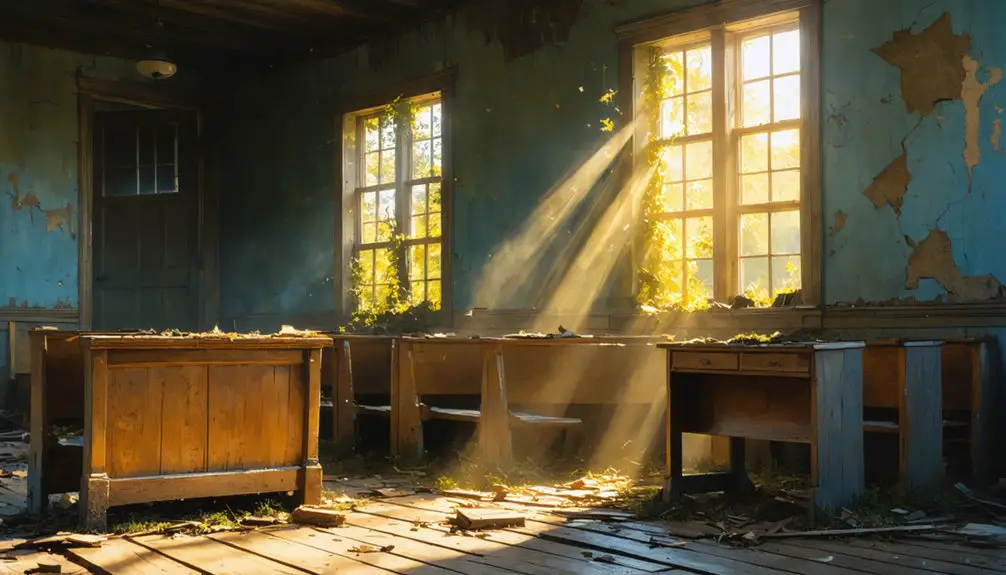
Two essential pillars of Lost Cove’s community life stood at its heart: the church and schoolhouse. You’d find these simple, utilitarian structures centrally located within walking distance for all residents.
The church fostered religious zeal through Sunday sermons and community gatherings, while strengthening familial bonds and moral values among the isolated settlers.
In Lost Cove’s simple church, faith and fellowship forged unbreakable bonds among mountain families seeking spiritual comfort in their remote sanctuary.
The schoolhouse served dual purposes, offering basic education and hosting civic meetings. Local teachers taught multiple grade levels in one room, instilling literacy and arithmetic skills fundamental for self-reliance.
Both buildings, constructed from local materials, became critical social hubs where you’d witness everything from weddings to community decision-making. Their educational legacy lives on through oral histories and preserved remnants, drawing researchers and visitors exploring Appalachian heritage in Pisgah National Forest.
The Last Days of Lost Cove
You’ll find the departure of Lost Cove’s final residents in 1957 marked the quiet transformation of a once-vibrant community into a ghost town, as families gradually relocated for better economic opportunities.
The town’s last inhabitants preserved cherished memories of neighborly bonds, shared meals, and the self-reliant spirit that had defined their isolated mountain life.
Before their exodus, residents gathered one last time at the cemetery to pay respects to those who’d remain behind, marking the end of Lost Cove’s remarkable story of survival against the odds.
Final Families Move Away
The once-vibrant mountain community of Lost Cove reached its final chapter in 1957 when the last remaining family departed, marking the end of a gradual exodus that had intensified throughout the 1950s.
You can trace these final departures to multiple economic factors: the collapse of the logging industry, the railroad’s withdrawal of services, and the inability to sustain local farming and moonshine operations.
Without road access, you’d have found it increasingly difficult to maintain connections with the outside world.
As the community’s social fabric unraveled – with the closure of schools and declining church attendance – younger residents sought opportunities elsewhere.
Each departure weakened the town’s liveliness until the last family’s move marked Lost Cove’s transformation into the ghost town you’ll find today.
A Town’s Quiet End
During the mid-1950s, Lost Cove’s slow descent into abandonment accelerated as its remaining economic lifelines withered away.
Despite generations of community resilience and economic adaptation through logging, railroading, and even moonshine production, the town’s isolation finally proved insurmountable.
You’d have witnessed the heart-wrenching closure of the church and school, once-vibrant centers of daily life that fell silent as families departed one by one.
Memories Before Departure
Life in Lost Cove’s waning days painted a complex portrait of resilience and community bonds, even as residents faced their settlement’s inevitable end.
You’d have found a tight-knit community of about 100 people, sharing their lives across 400 acres of fertile mountain soil. The church and school served as beating hearts of community nostalgia, where shared stories echoed through funeral services and sermons.
Despite their isolation, families supported each other while maintaining their independent spirit through farming, moonshining, and forest harvesting. Their deep connection to the land persisted even as logging declined and railroad service ended.
As the last residents prepared to leave around 1957, they carried with them an unbreakable mountain culture that blended frontier resourcefulness with neighborly care.
Fire and Nature’s Reclamation
Since devastating fires swept through Lost Cove in 2007, nature has steadily reclaimed this once-vibrant mountain community. The fire aftermath destroyed most remaining structures, including three historic houses and Swin Miller’s rusted Chevy, leaving little tangible evidence of human settlement.
You’ll now find nature’s dominance on full display as the surrounding Pisgah National Forest encroaches on former farmland and logging sites. Where settlers once cleared paths and built homes, thick vegetation breaks down foundations and obscures old trails.
The rough terrain that initially challenged residents now shields the ghost town from easy access. Native wildlife has returned, and the ecosystem continues to heal from decades of logging and farming.
Even the industrial railroad beds have surrendered to the unstoppable force of natural succession.
Legends and Local Tales
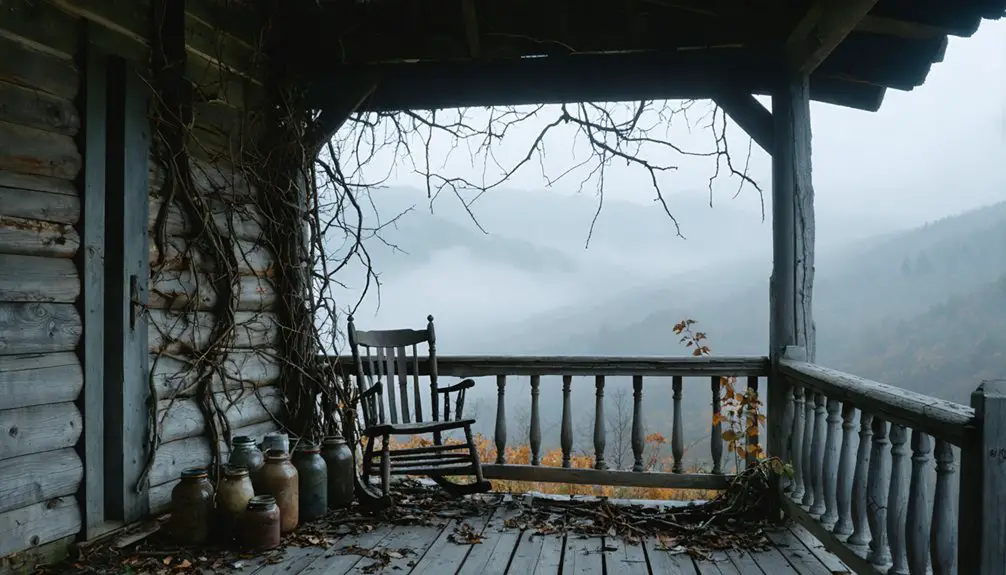
While Lost Cove‘s physical remains have largely vanished, the town’s rich folklore continues to captivate local historians and visitors alike.
Hidden histories trace the settlement’s origins to Civil War soldier Morgan Bailey, though some folklore origins suggest earlier ties to Daniel Boone’s era. You’ll find tales of fierce independence woven through stories of moonshine production and border disputes.
- Local legends claim the town existed in a jurisdictional “no man’s land” between North Carolina and Tennessee.
- Stories emphasize a resilient community where neighbors united against harsh mountain conditions.
- Tales of moonshining and encounters with law enforcement highlight the town’s reputation for autonomy.
The community’s isolation fostered both self-reliance and lawlessness, creating an enduring mystique of a hidden Appalachian settlement where residents lived by their own rules.
Exploring the Ghost Town Today
Tucked away in Yancey County, North Carolina, Lost Cove‘s remnants await explorers willing to undertake a challenging trek through rugged Appalachian terrain.
You’ll need proper navigation tools and hiking preparation to reach this remote ghost town, as no roads lead directly to the site.
When you arrive, you’ll discover three standing houses and a historic cemetery among the mountain wilderness.
The rusted remains of Swin Miller’s Chevy still rest in a nearby ditch, while scattered artifacts from the logging and railroad era dot the landscape.
Time stands frozen as Swin Miller’s rusted Chevy rests eternally in its earthen grave, surrounded by whispers of Lost Cove’s industrial past.
While the 2007 fires destroyed many original structures, the site’s natural reclamation by forest creates an immersive experience.
Keep in mind that seasonal weather can affect your exploration challenges – winter snows and spring rains often make the already difficult hiking conditions treacherous.
Frequently Asked Questions
Are There Any Known Paranormal Activities Reported in Lost Cove?
While you’ll find reports of ghost sightings at haunted locations like the abandoned church and cemetery, there’s no scientific evidence – just local legends and visitors’ unconfirmed encounters with paranormal activity.
What Happened to the Families Who Left Lost Cove After 1957?
You’ll find family legacies scattered across Tennessee and North Carolina, where most residents moved after economic decline forced them out. They took jobs in manufacturing, mining, and urban centers for survival.
Were Any Movies or Documentaries Filmed in Lost Cove?
You won’t find any major movies or documentary features filmed in this remote location. While it’s appeared in some hiking and exploration videos, established film locations stick to North Carolina’s more accessible areas.
Did Any Famous Historical Figures Ever Visit Lost Cove?
You won’t find evidence of any famous visitors in Lost Cove’s historical records. The town’s remote location and difficult terrain limited its historical significance to local families and regional industry.
Are There Ongoing Preservation Efforts to Protect Lost Cove’s Remaining Structures?
You’ll find limited preservation techniques in place today, though the U.S. Forest Service protects the area’s historical significance. The remaining structures face ongoing deterioration despite federal stewardship and past SAHC conservation efforts.
References
- https://en.wikipedia.org/wiki/Lost_Cove
- https://dc.etsu.edu/etd/2147/
- https://thelaurelofasheville.com/lifestyle/history-feature-love-and-lawlessness/
- https://www.appalachianhistory.net/2021/04/the-vanished-community-of-lost-cove.html
- https://wnchistory.org/lost-cove-nc/
- https://appalachian.org/get-connected/explore-protected-lands/lost-cove/
- https://appalachian.org/lost-cove-ghost-town-in-the-national-forest/
- https://www.youtube.com/watch?v=FDZ3eqMmug8
- https://www.howlingmoonshine.com/general-5-1
- https://www.howlingmoonshine.com/history-of-moonshine
